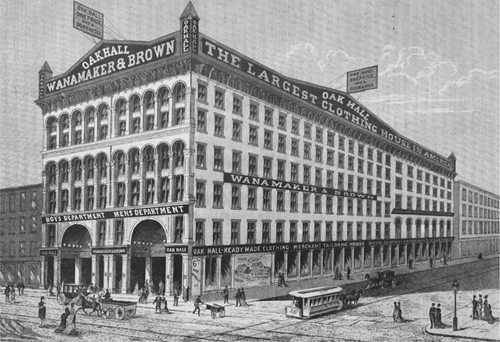
John Wanamaker was the epitome of a great business man who understood civic responsibilities.
—Governor Ed Rendell, former mayor of Philadelphia, 1991—1999
Apparently John Wanamaker was a very nice and very broad-minded man” states Louise Wanamaker. Her husband’s great-grandfather changed the way America did its business. In the past, customers bargained with shop owners in order to obtain the best price. Only the shrewdest merchant and the savviest customer were ever truly satisfied with a sale. But that all changed when John Wanamaker opened his doors.
John Wanamaker was born in 1838 and grew up in the Greys Ferry neighborhood of South Philadelphia. He was the oldest of seven children, and his parents were devout Presbyterians. His parents reared John to be just as devout and loyal to the Presbyterian faith. At the age of fourteen, John left school and went to work as an errand boy. But two years later, he received his first taste of retail work when he took a job in a men’s clothing store. When he was nineteen, Wanamaker changed direction and worked at the Philadelphia YMCA. He was appointed secretary and became the first full-time YMCA secretary in America. At the same time, he founded the Bethany Sunday School on South Street. Wanamaker was passionate about his work, and in time Bethany became the largest Sunday school in America. While at Bethany, he met Mary Brown. Mary was a student at Bethany, and, in 1860, the two were married.

An early image of a young John Wanamaker. Courtesy of the author.
Wanamaker enjoyed his work at the YMCA but he still craved his own business. Torn between his religious activities and the new world of commerce, he turned his attention toward commerce. Wanamaker partnered with his brother-in-law, Nathan Brown, and established a men’s and boys’ store named Oak Hall—Wanamaker & Brown. The store, located at Sixth and Market Streets, opened on April 8, 1861, just three days before the start of the Civil War. It might not have been the best time to start a business, so Wanamaker and Brown relied on unorthodox means to promote their business. The day before the doors opened, Wanamaker posted signs and banners throughout Philadelphia that simply said “W&B.”1 People did not know what the initials stood for and they sought out their meaning. The few customers that showed up on that first day quickly grew in number, and it is clear that the modern age of retail advertising began with those simple W&B signs.
Wanamaker & Brown took in $24.67 on their first day of business. John continued to believe in the power of advertising. He spent his first $24.00 on newspaper advertisements and kept the remaining $0.67 for change. Wanamaker & Brown used billboards and balloons to promote the store. A healthy combination of revolutionary advertising and strong customer service turned Oak Hall—Wanamaker & Brown into a very successful business. With the Civil War progressing, Wanamaker & Brown was able to grow its new organization. The two businessmen successfully received contracts to produce military uniforms and local city officials’ garments.

An image of the original Oak Hall, Wanamaker & Brown men’s clothing store at Sixth and Market Streets. Courtesy of the Historical Society of Pennsylvania.
In 1865, Wanamaker revolutionized retailing by offering money back if a customer was dissatisfied with his or her purchase. This policy was just unheard of at the time. Wanamaker even boldly advertised “those who are not pleased with what they buy, do us a positive favor to return the goods and get the money back.” He was eager to build customer satisfaction, and he hoped that his goods and services would not fail to “please the folks at home.” In addition to this new form of reciprocity, Wanamaker began marking the prices on his goods. He disliked bargaining. Wanamaker believed that bargaining resulted in harm to both the customer and the merchant.2 This one-price policy was revolutionary at the time but it soon became the accepted method for conducting retail business.
Nathan Brown passed away in November 1868, granting Wanamaker sole control of the operation. In April 1869, he opened a second, more exclusive store near the intersection of Ninth and Chestnut Streets. Business continued to grow at both stores, and, by 1871, Wanamaker & Brown was the largest men’s store in the country.3 By 1871, sales at the two Wanamaker stores exceeded $2 million a year. Wanamaker became the first American retailer to travel overseas to buy merchandise, and he especially loved traveling to England. He purchased items for his “everyone’s the best” customers because the British goods were “the best money could buy.”4 Both of his stores carried men’s clothing exclusively but his travels abroad opened Wanamaker’s eyes to all the possibilities of unique merchandise offerings. In 1874, he made the bold decision to buy the large, abandoned Pennsylvania Railroad freight station at Thirteenth and Market Streets. A new era of Philadelphia retailing was born.